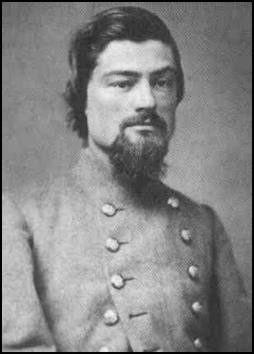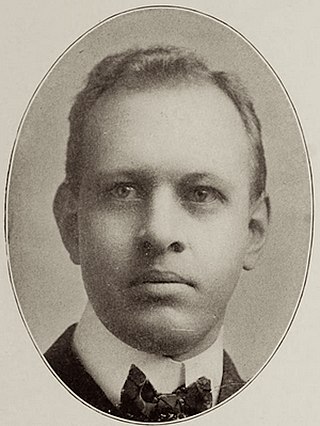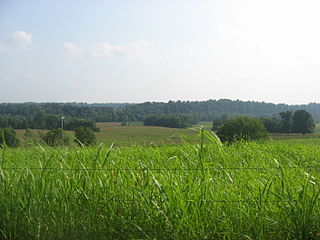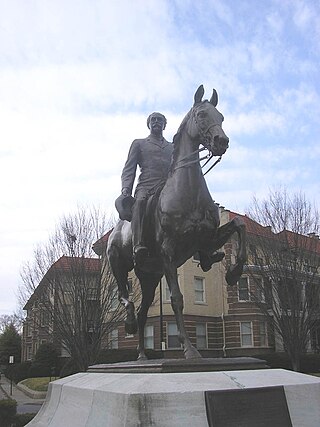Related Research Articles

John Hunt Morgan was an American soldier who served as a Confederate general in the American Civil War of 1861–1865.

John Pope was a United States Senator from Kentucky, a member of the United States House of Representatives from Kentucky, Secretary of State of Kentucky, and the third Governor of Arkansas Territory.

Transylvania University is a private university in Lexington, Kentucky. It was founded in 1780 and was the first university in Kentucky. It offers 46 major programs, as well as dual-degree engineering programs, and is accredited by the Southern Association of Colleges and Schools. Its medical program graduated 8,000 physicians by 1859.

The geology of the Ohio River, with but a single series of rapids halfway in its length from the confluence of the Monongahela and Allegheny rivers to its union with the Mississippi, made it inevitable that a town would grow on the site. Louisville, Kentucky was chartered in the late 18th century. From its early days on the frontier, it quickly grew to be a major trading and distribution center in the mid 19th century, important industrial city in the early 20th, declined in the mid 20th century, before revitalizing in the late 20th century as a culturally-focused mid-sized American city.

Crescent Hill is a neighborhood four miles (6 km) east of downtown Louisville, Kentucky USA. This area was originally called "Beargrass" because it sits on a ridge between two forks of Beargrass Creek. The boundaries of Crescent Hill are N Ewing Ave to the St. Matthews city limit by Brownsboro Road to Lexington Road. Frankfort Avenue generally bisects the neighborhood.

Basil Wilson Duke was a Confederate general officer during the American Civil War. His most noted service in the war was as second-in-command for his brother-in-law John Hunt Morgan; Duke later wrote a popular account of Morgan's most famous raid: 1863's Morgan's Raid. He took over Morgan's command after Morgan was shot by Union soldiers in 1864. At the end of the war, Duke was among Confederate President Jefferson Davis's bodyguards after his flight from Richmond, Virginia, through the Carolinas.

William James Dodd (1862–1930) was an American architect and designer who worked mainly in Louisville, Kentucky from 1886 through the end of 1912 and in Los Angeles, California from early 1913 until his death. Dodd rose from the so-called First Chicago School of architecture, though of greater influence for his mature designs was the classical aesthetic of the Beaux-Arts style ascendant after the Chicago World's Columbian Exposition of 1893. His design work also included functional and decorative architectural glass and ceramics, furniture, home appliances, and literary illustration.

The Battle of Tebbs' Bend was fought on July 4, 1863, near the Green River in Taylor County, Kentucky during Morgan's Raid in the American Civil War. Despite being badly outnumbered, elements of the Union army thwarted repeated attacks by Confederate Brig. Gen. John Hunt Morgan's dismounted cavalry.

Kentucky was a border state of key importance in the American Civil War. It officially declared its neutrality at the beginning of the war, but after a failed attempt by Confederate General Leonidas Polk to take the state of Kentucky for the Confederacy, the legislature petitioned the Union Army for assistance. After early 1862 Kentucky came largely under Union control. In the historiography of the Civil War, Kentucky is treated primarily as a border state, with special attention to the social divisions during the secession crisis, invasions and raids, internal violence, sporadic guerrilla warfare, federal-state relations, the ending of slavery, and the return of Confederate veterans.

Thomas Henry Hines was a Confederate cavalryman who was known for his spying activities during the last two years of the American Civil War. A native of Butler County, Kentucky, he initially worked as a grammar instructor, mainly at the Masonic University of La Grange, Kentucky. During the first year of the war, he served as a field officer, initiating several raids. He was an important assistant to John Hunt Morgan, doing a preparatory raid in advance of Morgan's Raid through the states of Indiana and Ohio, and after being captured with Morgan, organized their escape from the Ohio Penitentiary. He was later involved in espionage and tried to stir up insurrections against the Federal government in selected Northern locales.

The Hunt–Morgan House, historically known as Hopemont, is a Federal style residence in Lexington, Kentucky built in 1814 by John Wesley Hunt, the first millionaire west of the Alleghenies. The house is included in the Gratz Park Historic District. The Alexander T. Hunt Civil War Museum is located on the second floor of the Hunt–Morgan House.

Gratz Park is a neighborhood and historic district located just north of downtown Lexington, Kentucky. It was named after early Lexington businessman Benjamin Gratz whose home stands on the corner of Mill and New streets at the edge of Gratz Park. The Gratz Park Historic District consists of 16 contributing buildings including the Hunt-Morgan House, the Bodley-Bullock House, the original Carnegie Library in Lexington, and several other private residences. Gratz Park occupies a tract of land that was established in 1781 outside the original boundaries of Lexington.

The John Hunt Morgan Memorial in Lexington, Kentucky, is a monument created during the Jim Crow era, as a tribute to Confederate General John Hunt Morgan, who was from Lexington and is buried in Lexington Cemetery. The monument was originally situated on the Courthouse Lawn at the junction of North Upper and East Main Street, but was moved to Lexington Cemetery in 2018.

The John B. Castleman Monument, within the Cherokee Triangle of Louisville, Kentucky, was unveiled on November 8, 1913. The model, selected from a competition to which numerous sculptors contributed, was designed by R. Hinton Perry of New York. The statue was erected to honor John Breckinridge Castleman at a cost of $15,000 by popular subscription from city, state, and other commonwealths. The statue is made of bronze, and rests on a granite pedestal. It stands 15-feet high, with a base of 12×20 feet. The monument was placed on the National Register of Historic Places on July 17, 1997, as part of the Civil War Monuments of Kentucky MPS. There have been attempts to remove the statue since January 2019 due to the fact that Castleman was a Major of the Confederate army. The monument was removed on June 8, 2020, and is pending cleaning and relocation to Castleman's burial site.
Clay Lancaster, was an authority on American architecture, an orientalist, and an influential advocate of historical preservation. According to The New York Times, Lancaster's 1961 study of the architecture of Brooklyn Heights "proved to be one of the earliest and loudest shots in the historic preservation struggle in New York City.”

James Ben Ali Haggin was an American attorney, rancher, investor, art collector, and a major owner and breeder in the sport of Thoroughbred horse racing. Haggin made a fortune in the aftermath of the California Gold Rush and was a multi-millionaire by 1880.

Lexington, Kentucky was a city of importance during the American Civil War, with notable residents participating on both sides of the conflict. These included John C. Breckinridge, Confederate generals John Hunt Morgan and Basil W. Duke, and the Todd family, who mostly served the Confederacy although one, Mary Todd Lincoln, was the first lady of the United States, wife of President Abraham Lincoln.

Abraham "Abe" Buford II was an American soldier, Confederate combatant, and landowner. After serving in the United States Army during the Mexican–American War, Buford joined the Confederate States Army in 1862 and served as a cavalry general in the Western Theater of the American Civil War. After the war, he retired to his native Kentucky and became a thoroughbred horse breeder.

The Cherokee Triangle is a historic neighborhood in Louisville, Kentucky, USA, known for its large homes displaying an eclectic mix of architectural styles. Its boundaries are Bardstown Road to the southwest, Cherokee Park and Eastern Parkway to the southeast, and Cave Hill Cemetery to the north, and is considered a part of a larger area of Louisville called The Highlands. It is named for nearby Cherokee Park, a 409 acres (1.7 km2) park designed by Frederick Law Olmsted, the designer of New York's Central Park.

Julia Blackburn Duke Henning was an American suffragist and clubwoman, based in Louisville, Kentucky.
References
- ↑ "National Register Information System". National Register of Historic Places . National Park Service. April 15, 2008.
- 1 2 Bevins, Ann (1973). "Abram-Buford – James K. Duke House". National Park Service. Retrieved 4 February 2015.
- 1 2 Cahal, Sherman. "James J. Duke House". Abandoned. Archived from the original on 4 February 2015. Retrieved 5 February 2015.
- ↑ Coleman, Winston (1968). "James K. Duke House". Historic Kentucky. Lexington: Henry Clay Press. p. 19.